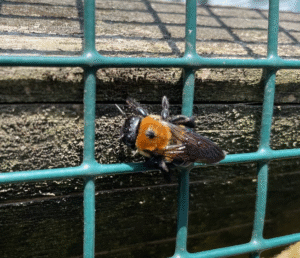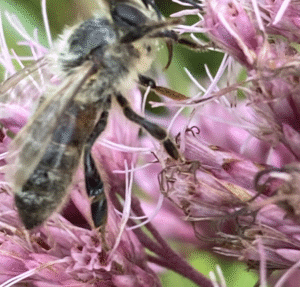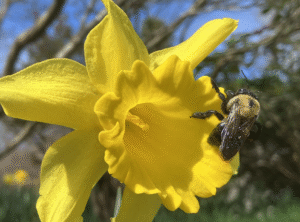
Eastern Carpenter Bee by Kristen Peterson (iNaturalist)
The Fishers Island Conservancy is helping Fishers Island Waste Management District get people buzzing about why bees are so important to the ecosystem and what are the non-lethal ways to reduce bees being drawn to our waste areas.
If you have an allergy or are otherwise concerned, please ask our attendants to dispose of your household trash and recycling for you. Your safety is our priority.
Why Bees Sting (and Why It’s Rare)
Please note that typically, the act of a bee stinging someone is far more dangerous to the bee itself than the person they are attempting to sting. This is because the stinger is often barbed and difficult to remove from the skin of a vertebrate—in some cases, the stinger itself remains embedded and the insect disembowels itself in the process of trying to get free.
Honeybee workers, which can have up to thousands in the hive, are expendable and their hive can afford the workers to sacrifice themselves like this.
Our native bees rarely sting as they are mostly solitary; however, both solitary and honeybees would likely be attracted to the same kind of lethal trap or poison that might be considered an option.
Why Bee Traps Don’t Work

Western Honey Bee by Murray Fisher (iNaturalist)
Bee traps are ineffective in reducing the numbers of bees, and are even potentially counterproductive because they are baited to attract bees.
Sugary residues, food waste, and certain scents naturally attract them, especially when alternative foraging options are limited.
What You Can Do
While there will likely be no foolproof way to keep the bees from being attracted to any sweet-smelling waste, there are ways to mitigate the situation.
Pick up your complementary green 7-gallon bucket from the Compost Station and start separating your food scraps from your household trash. This diverts heavy wet materials from being a waste that is shipped off island into a resource that turns into beautiful free compost for your garden.
This also means less sweet-smelling household trash at the transfer station which will in turn attract fewer bees.
Rinse your recycling—this will also lessen the attractiveness to bees.
And, again, please know that our attendants are there to help you and can dispose of your trash and recycling on your behalf.
A Healthy Bee Population is a Good Sign
Seeing bees around the island is actually a good sign! It reflects the health and resilience of our local ecosystems and shows that our island continues to support a strong pollinator population.
Pollinator gardens provide high-quality food sources away from human areas, helping reduce direct bee-human encounters.
Traps, on the other hand, are largely ineffective because they kill indiscriminately, often harming beneficial or harmless species, and they don’t address the real attractants like unwashed recycling or food waste.
Broader native habitat improvements, like invasive plant removal and native species planting, will go a long way toward creating sustainable solutions that benefit pollinators and the larger ecosystem.
Bee ID: Who’s Buzzing Around?

Common Eastern Bumble Bee by Steffen Kucsera
Not all bees are the same, and not all are likely to sting or even live in colonies. Here’s how to tell some of our most common bee visitors apart:
Honey Bees
These bees are small and golden-brown with fuzzy bodies. They live in large colonies and are social pollinators. Honey bees are the ones that produce honey and can sting, but usually only when threatened.
Bumble Bees
Bumble bees are larger and rounder, with very fuzzy black-and-yellow bodies. They’re also social but tend to be gentle. Bumble bees are excellent pollinators and rarely sting.
Carpenter Bees
Carpenter bees look similar in size to bumble bees but have shiny, hairless black abdomens. They’re often spotted near wooden structures, where they create small nesting holes. Males don’t sting, and females usually won’t unless directly handled.
Knowing which bee you’re seeing helps reduce fear and encourages appreciation for the vital role they play in our environment!
![]()